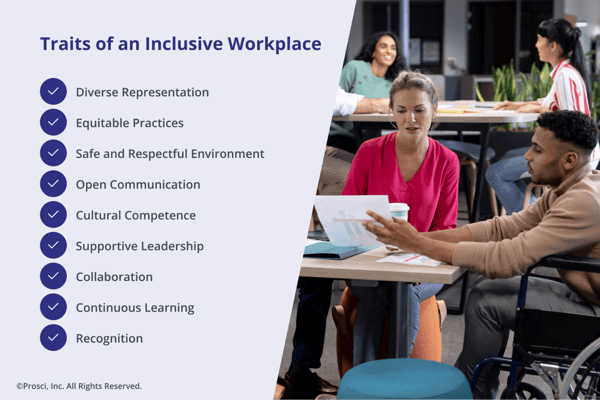How Change Management Can Drive Inclusion in the Workplace

7 Mins
Updated: July 31, 2024
Published: May 6, 2024

Inclusion in the workplace ensures that a diverse workforce, including employees of different ages, religions, beliefs, sexual orientations and identities, can work without friction. Creating an inclusive culture requires change, a move away from outdated practices and policies and toward newer standards that create a healthy environment.
In this article, we'll explore why inclusion is essential at work, what an inclusive workplace looks like, and how to implement changes that build inclusivity.
What Is Inclusion in the Workplace?
Inclusion in the workplace creates a culture where employees feel safe, valued and supported, regardless of their background, status or identity. Inclusion is vital to creating a thriving work environment where diverse perspectives and ideas are recognized and appreciated.
In fact, employees appreciate inclusion efforts, with 56% of workers in a recent survey saying that focusing on increasing diversity, equity and inclusion at work is a good thing.
Inclusion involves proactive efforts to eliminate barriers to participation and encourage employees to foster change. Organizations can achieve this through policies that promote equality, such as flexible working arrangements, diversity training, and mentorship programs.
An inclusive workplace benefits both workers and organizations. It leads to increased engagement, higher job satisfaction, and better retention rates. For organizations, inclusion drives innovation, enhances problem-solving capabilities, and improves performance.
By leveraging employees' diverse talents and experiences, companies can create a more dynamic, productive and harmonious work environment.
Prosci research shows that culture change is the second most common project organizations undertake. Building inclusion is a type of cultural change, and it can be a complex process that fundamentally changes how employees work and interact with peers, managers and leadership.
Leaders also play a critical role in inclusion initiatives. Change practitioners must educate leaders so that they commit to and guide the implementation of strategies. They also need to model inclusive behavior and create mechanisms for accountability.
Given that inclusion projects require large-scale change, organizations need to implement change management to drive the transition from the current state to the future desired state.
Need to implement critical DEI initiatives? Our expert Change Advisors can support you every step of the way.
The Benefits of an Inclusive Workplace
Diversity, Equity and Inclusion (DEI) projects are great opportunities for businesses to demonstrate their values and commitment to employees. These projects are very personal to people and how they view themselves.
When companies execute DEI initiatives effectively, employees feel they belong and are advocated for. This sense of belonging also contributes to organizational success. Here's how:
- Better innovation and creativity – Employees from different backgrounds contribute unique viewpoints, leading to creative problem-solving and more comprehensive solutions. Innovative ideas can flourish in inclusive teams.
- Improved employee retention and satisfaction – An inclusive employee experience can increase job satisfaction. This sense of belonging boosts morale and motivation, creating a more positive work atmosphere.
- Better retention – Inclusive workplaces have higher employee retention rates. When employees feel respected and supported, they are less likely to leave. This helps maintain a stable and experienced workforce and reduces turnover costs.
- Increased productivity – Inclusive environments promote collaboration and teamwork, leading to higher productivity. Employees who feel their work matters are more likely to go above and beyond in their roles, boosting overall organizational performance.
- Greater market insight – A diverse workforce can provide better insights into different market segments, helping the organization understand and meet the needs of a broader customer base. This can help gain a competitive advantage and increase market share.
An inclusive workplace culture can also improve recruitment by broadening the talent pool. It can also elevate the brand image and simplify compliance with equal employment opportunity laws and ethical standards.
These factors highlight how inclusion is a moral imperative and a strategic advantage that enhances employee engagement and organizational success. It shows your employees, customers, clients and partners you’re committed to creating a fair and just workplace.
The Traits of an Inclusive Workplace
You can characterize an inclusive workplace by specific traits that help employees feel respected and supported. Here are some key traits:

- Diverse representation – The workforce reflects a variety of backgrounds, including different races, genders, ages, abilities and experiences. There’s diverse representation at all levels, including senior and leadership positions.
- Equitable practices – Develop policies and practices that ensure equal access to opportunities, resources and career advancement. There are also fair and transparent hiring, promotions, and compensation processes.
- Safe and respectful environment – Apply mechanisms for addressing and resolving conflicts and complaints fairly, along with zero-tolerance policies for discrimination and harassment.
- Open communication – Employees have channels to share ideas, concerns and feedback without fear of retaliation. They’re encouraged to have an open and honest dialogue about diversity, inclusion and equity.
- Cultural competence – There’s an understanding and appreciation of varied backgrounds and perspectives. For example, inclusive organizations have training programs that educate employees on cultural competence and unconscious bias.
- Supportive leadership – Leaders actively promote diversity and inclusion by modeling inclusive behavior and holding themselves and others accountable. They’re also approachable and listen to the concerns of all employees.
- Collaboration – The work culture values collaboration and encourages teamwork across groups. All team members' contributions are recognized, creating a sense of mutual respect.
- Continuous learning – Employees have professional growth and development opportunities.
- Recognition – There are inclusive criteria for awards and recognitions that reflect the organization's commitment. There are systems to celebrate diverse contributions and achievements.
An inclusive workplace embodies these traits and fosters an environment where employees can thrive and contribute their best.
Empowering Inclusive Workplaces With Change Management
Change management and inclusion in the workplace are interconnected concepts that lead to successful cultural change.
Encouraging inclusion requires implementing strategies or policies that shift company culture. Leaders and practitioners can make the transition an inclusive process by using a structured change management approach.
Applying the Prosci Methodology enables change practitioners to involve several stakeholders in planning and executing inclusion programs, resulting in a long-term cultural shift in the organization.
The role of leadership in championing workplace inclusion
The first step in any organizational change is to get leadership commitment. Leadership includes senior managers and executives. Without buy-in from a leader, DEI initiatives will struggle.
Every change requires a primary sponsor. This individual is the leader who authorizes the change and ensures it achieves its goals. For large-scale change initiatives, this sponsor enlists other business leaders, executives and managers to form a group of sponsors.
The primary sponsor drives the change, allocates resources, and leads by example. The other sponsors champion organizational change by encouraging employees to adopt inclusive practices.
Leaders are vital for cultivating inclusion. They’re seen as role models who showcase and spread inclusive behavior to employees. In a survey of US workers, 62% said that they would consider turning down a job offer or leaving a company if they did not think that their manager (or potential manager) supported DEI initiatives.
With a repeatable, actionable framework to guide them, practitioners can ensure leaders model inclusive behavior and act as good sponsors. This includes setting clear expectations for the cultural shift and getting dedicated resources for change management.
Prosci research found that 74% of projects with sufficient or more than sufficient dedicated resources achieved good or excellent change management effectiveness.
Relationship Between Sufficient Resources and Change Management Effectiveness

Once the groundwork for organizational change is in place and leaders are engaged, it’s time to focus on individual change.
Our ADKAR Model and Inclusion
Successful organizational change requires widespread individual change, and the Prosci ADKAR® Model is a powerful framework for enabling change at the individual level.
Our ADKAR model has five building blocks: Awareness, Desire, Knowledge, Ability and Reinforcement. Each block helps employees move through the stages of understanding why a change is necessary and then adopting it.
Prosci ADKAR Model

Here’s how the ADKAR Model helps execute DEI initiatives:
1. Building awareness and desire
Employees must understand why a change is happening to invest in it. To build awareness of the change, practitioners use activities like employee communication, sponsor messages and managers' conversations.
These activities help communicate why inclusion is important, share relevant data, and highlight stories that showcase its benefits. Change professionals can also use surveys and feedback mechanisms to understand employees and existing barriers related to inclusion. They can use this information to guide their awareness strategy.
Effective communication is crucial to developing awareness about inclusion initiatives. Messages must be consistent, provide clarity, and be sent at the right frequency by the right people.
Prosci research found that employees prefer to receive organizational messages about change from the CEO, president, or another executive. They prefer communication about the personal impact of change to come from their direct supervisor.
Preferred Senders of Messages

An example of an activity to increase awareness is a town hall meeting where senior leaders discuss the importance of inclusion and present data on the benefits.
Once employees know why a change is happening, they need to know, "What's in it for me?" They need motivation or desire to participate in a change, such as incentives, fear of consequences, and wanting to follow a trusted leader.
Other barriers to building desire exist during DEI initiatives. Employees can feel that the initiatives are only for people with minoritized identities. If somebody holds a majority identity and might have what we consider privilege, they may think that the DEI initiative isn’t for them.
There's also an undercurrent of people feeling like the change is political when it's not. Practitioners and leaders must clarify that the change benefits everybody, not just a specific group.
To do this, they need a strong coalition of sponsors led by an active and visible primary sponsor. They also need to highlight the professional benefits of inclusion and proactively manage resistance.
Another way to develop desire is to involve employees so they feel a sense of ownership. You can also encourage participation in Employee Resource Groups (ERGs) and inclusion task forces.
Examples of activities to increase desire for DEI include campaigns featuring employee testimonials about the positive impacts of inclusion or workshops where employees can discuss inclusion and brainstorm ideas.
2. Developing Knowledge and Ability
The third block of our ADKAR model is Knowledge. Employees must know what to do during the transition and how to incorporate these effectively.
Practitioners can build knowledge with comprehensive training programs to educate employees about unconscious bias, cultural competence and inclusive practices. They can also create and communicate policies and guidelines to support these practices.
For example, organizations can provide mandatory DEI training for all employees to gain knowledge. They can also create a resource hub with articles and videos showing how to practice inclusion daily.
Once employees know what to do during and after the transition, it's time to develop the skills required to perform them.
To develop this ability, organizations can offer workshops, simulations, and real-world scenarios for employees to practice inclusive behaviors. They can also provide mentorship, coaching and support systems.
During the change planning stages, it's important to allow adequate time and resources for training and development. Employees will need time to implement and excel at the new skills they learn.
3. Implementing Reinforcement strategies
Achieving the goals of an inclusion initiative can be difficult, but change leaders and practitioners need to look beyond short-term benefits. A change is only successful if adopted in the long term.
If organizations jump from one change to the next immediately after completion, employees can abandon inclusive behaviors and practices, choosing to focus on the latest change instead. To avoid this, change leaders must plan for reinforcement.
Reinforcement also positively impacts change success, with 81% of research participants who planned for reinforcement or sustainment activities meeting or exceeding project objectives.
Impact of Planning for Reinforcement on Project Success

Reinforcing inclusion involves rewarding individuals and teams who contribute to creating inclusive work environments. Organizations can also celebrate milestones and achievements related to inclusion.
Change leaders must also regularly assess their initiatives through surveys, feedback and performance metrics. This helps make improvements based on changing organizational needs.
Prosci Drives Inclusion in the Workplace
Inclusive organizations nurture creativity, innovation and better decision-making, but building this environment requires change. Developing inclusion in the workplace is a change initiative that requires detailed planning and implementation. For successful inclusion initiatives, you need a structured change management framework like our ADKAR Model.


